+ Open data
Open data
- Basic information
Basic information
| Entry | Database: PDB / ID: 4q16 | ||||||
|---|---|---|---|---|---|---|---|
| Title | Structure of NAD+ Synthetase from Deinococcus radiodurans | ||||||
 Components Components | NH(3)-dependent NAD(+) synthetase | ||||||
 Keywords Keywords | LIGASE / NADS / NAD synthetase | ||||||
| Function / homology |  Function and homology information Function and homology informationNAD+ synthase / NAD+ synthase activity / NAD+ synthase (glutamine-hydrolyzing) activity / glutaminase activity / NAD+ biosynthetic process / ATP binding / metal ion binding / cytoplasm Similarity search - Function | ||||||
| Biological species |  Deinococcus radiodurans (radioresistant) Deinococcus radiodurans (radioresistant) | ||||||
| Method |  X-RAY DIFFRACTION / X-RAY DIFFRACTION /  SYNCHROTRON / SYNCHROTRON /  MOLECULAR REPLACEMENT / Resolution: 2.6 Å MOLECULAR REPLACEMENT / Resolution: 2.6 Å | ||||||
 Authors Authors | Lee, J.Y. / Park, Y.W. | ||||||
 Citation Citation |  Journal: To be Published Journal: To be PublishedTitle: Structural Analysis of the NH3-dependent NAD+ Synthetase from Deinococcus radiodurans Authors: Lee, J.Y. / Park, Y.W. / Yeo, H.K. | ||||||
| History |
|
- Structure visualization
Structure visualization
| Structure viewer | Molecule:  Molmil Molmil Jmol/JSmol Jmol/JSmol |
|---|
- Downloads & links
Downloads & links
- Download
Download
| PDBx/mmCIF format |  4q16.cif.gz 4q16.cif.gz | 212.5 KB | Display |  PDBx/mmCIF format PDBx/mmCIF format |
|---|---|---|---|---|
| PDB format |  pdb4q16.ent.gz pdb4q16.ent.gz | 170.3 KB | Display |  PDB format PDB format |
| PDBx/mmJSON format |  4q16.json.gz 4q16.json.gz | Tree view |  PDBx/mmJSON format PDBx/mmJSON format | |
| Others |  Other downloads Other downloads |
-Validation report
| Summary document |  4q16_validation.pdf.gz 4q16_validation.pdf.gz | 467.9 KB | Display |  wwPDB validaton report wwPDB validaton report |
|---|---|---|---|---|
| Full document |  4q16_full_validation.pdf.gz 4q16_full_validation.pdf.gz | 474.6 KB | Display | |
| Data in XML |  4q16_validation.xml.gz 4q16_validation.xml.gz | 40.9 KB | Display | |
| Data in CIF |  4q16_validation.cif.gz 4q16_validation.cif.gz | 57.2 KB | Display | |
| Arichive directory |  https://data.pdbj.org/pub/pdb/validation_reports/q1/4q16 https://data.pdbj.org/pub/pdb/validation_reports/q1/4q16 ftp://data.pdbj.org/pub/pdb/validation_reports/q1/4q16 ftp://data.pdbj.org/pub/pdb/validation_reports/q1/4q16 | HTTPS FTP |
-Related structure data
| Similar structure data |
|---|
- Links
Links
- Assembly
Assembly
| Deposited unit | 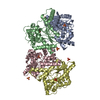
| ||||||||
|---|---|---|---|---|---|---|---|---|---|
| 1 | 
| ||||||||
| 2 | 
| ||||||||
| Unit cell |
|
- Components
Components
| #1: Protein | Mass: 31112.852 Da / Num. of mol.: 4 Source method: isolated from a genetically manipulated source Source: (gene. exp.)  Deinococcus radiodurans (radioresistant) Deinococcus radiodurans (radioresistant)Strain: R1 / Gene: nadE, DR_A0201 / Production host:  #2: Chemical | ChemComp-SO4 / #3: Water | ChemComp-HOH / | |
|---|
-Experimental details
-Experiment
| Experiment | Method:  X-RAY DIFFRACTION / Number of used crystals: 1 X-RAY DIFFRACTION / Number of used crystals: 1 |
|---|
- Sample preparation
Sample preparation
| Crystal | Density Matthews: 3.16 Å3/Da / Density % sol: 61.05 % |
|---|---|
| Crystal grow | Method: vapor diffusion, sitting drop / pH: 6 Details: 20% Poly ethylene glycol (PEG) 4000, 0.2M lithium sulfate, 0.1M MES pH 6.0, VAPOR DIFFUSION, SITTING DROP |
-Data collection
| Diffraction | Mean temperature: 100 K |
|---|---|
| Diffraction source | Source:  SYNCHROTRON / Site: PAL/PLS SYNCHROTRON / Site: PAL/PLS  / Beamline: 7A (6B, 6C1) / Wavelength: 0.97933 Å / Beamline: 7A (6B, 6C1) / Wavelength: 0.97933 Å |
| Detector | Type: ADSC QUANTUM 210 / Detector: CCD / Date: Jun 19, 2013 |
| Radiation | Monochromator: YALE MIRRORS / Protocol: SINGLE WAVELENGTH / Monochromatic (M) / Laue (L): M / Scattering type: x-ray |
| Radiation wavelength | Wavelength: 0.97933 Å / Relative weight: 1 |
| Reflection | Resolution: 2.6→50 Å / Num. obs: 49185 / % possible obs: 100 % / Observed criterion σ(F): 2 / Observed criterion σ(I): 2 / Redundancy: 8.7 % / Biso Wilson estimate: 37.09 Å2 / Rmerge(I) obs: 0.096 / Net I/σ(I): 14.6 |
- Processing
Processing
| Software |
| |||||||||||||||||||||||||||||||||||||||||||||||||||||||||||||||||||||||||||||||||||||||||||||||||||||||||||||||||||||||||||||||||||||
|---|---|---|---|---|---|---|---|---|---|---|---|---|---|---|---|---|---|---|---|---|---|---|---|---|---|---|---|---|---|---|---|---|---|---|---|---|---|---|---|---|---|---|---|---|---|---|---|---|---|---|---|---|---|---|---|---|---|---|---|---|---|---|---|---|---|---|---|---|---|---|---|---|---|---|---|---|---|---|---|---|---|---|---|---|---|---|---|---|---|---|---|---|---|---|---|---|---|---|---|---|---|---|---|---|---|---|---|---|---|---|---|---|---|---|---|---|---|---|---|---|---|---|---|---|---|---|---|---|---|---|---|---|---|---|
| Refinement | Method to determine structure:  MOLECULAR REPLACEMENT / Resolution: 2.6→29.381 Å / FOM work R set: 0.7707 / SU ML: 0.4 / σ(F): 2 / σ(I): 2 / Phase error: 29.52 / Stereochemistry target values: Engh & Huber MOLECULAR REPLACEMENT / Resolution: 2.6→29.381 Å / FOM work R set: 0.7707 / SU ML: 0.4 / σ(F): 2 / σ(I): 2 / Phase error: 29.52 / Stereochemistry target values: Engh & Huber
| |||||||||||||||||||||||||||||||||||||||||||||||||||||||||||||||||||||||||||||||||||||||||||||||||||||||||||||||||||||||||||||||||||||
| Solvent computation | Shrinkage radii: 0.9 Å / VDW probe radii: 1.11 Å / Solvent model: FLAT BULK SOLVENT MODEL | |||||||||||||||||||||||||||||||||||||||||||||||||||||||||||||||||||||||||||||||||||||||||||||||||||||||||||||||||||||||||||||||||||||
| Displacement parameters | Biso max: 96.44 Å2 / Biso mean: 41.74 Å2 / Biso min: 14.51 Å2 | |||||||||||||||||||||||||||||||||||||||||||||||||||||||||||||||||||||||||||||||||||||||||||||||||||||||||||||||||||||||||||||||||||||
| Refinement step | Cycle: LAST / Resolution: 2.6→29.381 Å
| |||||||||||||||||||||||||||||||||||||||||||||||||||||||||||||||||||||||||||||||||||||||||||||||||||||||||||||||||||||||||||||||||||||
| Refine LS restraints |
| |||||||||||||||||||||||||||||||||||||||||||||||||||||||||||||||||||||||||||||||||||||||||||||||||||||||||||||||||||||||||||||||||||||
| LS refinement shell | Refine-ID: X-RAY DIFFRACTION / Total num. of bins used: 18
|
 Movie
Movie Controller
Controller



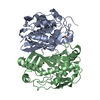
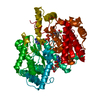



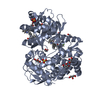

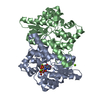
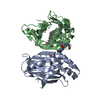
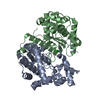
 PDBj
PDBj


